Dear Reader, in this age of AI created content, please support with your goodwill someone who works harder to provide the human-made. Sign up at the top of the lefthand column or bottom of this page. You will receive my hand illustrated monthly newsletter RESTORE NATURE and access to the biodiversity garden design course as I write...and nothing else, I respect your time. I am also removing the advertizing as best I can as its become intrusive inappropriate and pays me nothing.
combine making fruit vinegar and organic seeds
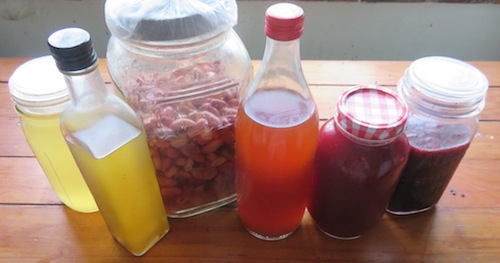 various types of fruit vinegar at various stages
various types of fruit vinegar at various stagesHow I got to integrate seed saving with making fruit vinegar
I got to combine fruit vinegar making and seed saving because a while back I started fermenting seed I was saving to loosen the seeds stuck to the fruit.
I had learned this at a seed saving workshop by Karen Parkin. Apparently it also protects the seeds against fungi. I started with pumpkins and then did tamarillos. I noticed that the perfume of the fermenting tamarillos was very fine, and this was also so for Carissa bispinosa and then Harpephyllum caffrum or wild plum, both African fruit trees. The seed fermented for several weeks.
 A forager's harvest. Wild plums gathered off the street.
A forager's harvest. Wild plums gathered off the street.The Harpehyllum has hard seeds that take months to germinate so I’m not sure of it worked for them. Very few Carissa germinated and then the seedlings disappeared again. However fermentation gave the tamarillos and the pumpkins a high germination rate.
My husband started making fruit vinegar for his cooking website lookingatcooking.com. I also describe how to make fruit vinegar on the website. He made plum first, and then pineapple.
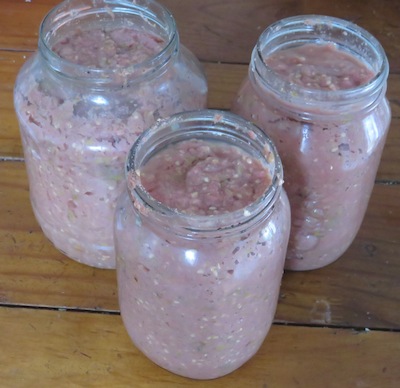 Mash the Guava in a processor and leave to ferment.
Mash the Guava in a processor and leave to ferment.How to make the vinegar
Because we have a glut of guavas full of worms every year, I had to just throw away the fruit. This year I wanted to suppress the fruit flies which lay eggs on the guavas. The fallen fruit needed to be collected every day and I thought hard about a better use for them than composting. I collected the fruit and made vinegar out of them. It didn’t take long to put two and two together and start making vinegar with the fruit from which I am harvesting organic seeds, using the fermentation that is part of processing the seed. This year will tell if they are still fertile after processing.
I crush the fruit and add a little sugar and water if there isn't enough pulp. It is important to crush the fruit so that they cannot form anaerobic botulism colonies in the closed envelope of the skin where the acids cannot penetrate. This is more of a threat when pickling less acid fruit like olives and cucumbers. I let it ferment for approximately a month. It should smell like wine at this stage. I then remove the seeds, filter the ferment and store it in a cool place loosely covered, to let it go sour. The ferment must be filtered several times at monthly intervals. The gelatinous skin which forms on the ferment is called the 'mother'. You can use it to inoculate other ferments apparently, but I found it didn't speed up the fermenting process.
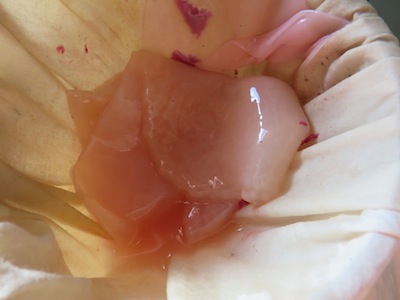 The Guava 'mother' after filtering.
The Guava 'mother' after filtering.Use any fruit for making vinegar
Since the first efforts I’ve made Numnum (Carissa bispinosa) vinegar, pineapple-lemon-herb vinegar, and I’m working on a Harpephyllum and a Tamarillo vinegar. I also have a grenadilla ferment which looks interesting, but the fruit were moldy when harvested and I don’t think its safe for human consumption. Likewise the Harpephyllum fruit lie on the street and then they also have tough skins which may encourage nasty anaerobes and botulism, so I plan to boil and render down the Harpephyllum vinegar into a sweet sour syrup.
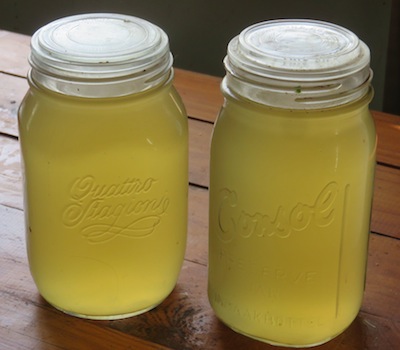 Pineapple, lemon and rosemary vinegar
Pineapple, lemon and rosemary vinegarThe benefits of home brewed vinegar
Boiling is a bit unfortunate as the wonderful thing about hand brewed fruit vinegar is the great live flora they contain. Our milk products and cheeses and sauerkraut are all pasteurized, and the wines disinfected, so there is precious little opportunity to consume lacto bacteria which are so good for the digestive tract. Some people are allergic to the lactose found in milk on which they thrive, so making fruit vinegar is a wonderful opportunity to make lactose free cultures containing some lactobacillus.
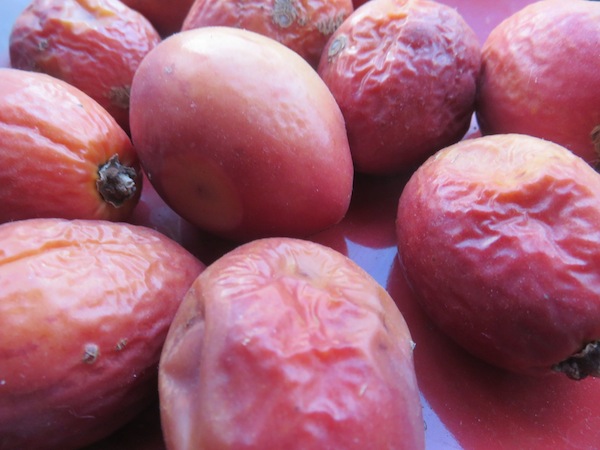 Over ripe tamarillos. Scoop out the seeds and ferment.
Over ripe tamarillos. Scoop out the seeds and ferment.Vinegar brewing is a simple process
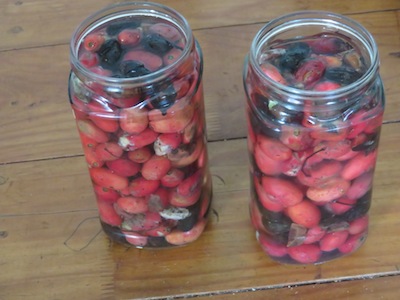 Don't use very rotten fruit for vinegar, but save the seed.
Don't use very rotten fruit for vinegar, but save the seed.The fermentation and formation of acid make this a relatively safe easy process, as the toxic microorganisms don't like acid, and the fruit tend to ferment rather than rot. I've tried making sauerkraut. The first batch was a
success. It was beginner’s luck. The subsequent batches failed and went stinky and brown, even
in the fridge. Sauerkraut is a much more complicated and finely tuned pickling process than
making vinegar which occurs naturally if you have over ripe fruit lying around. They go off, ferment
and then form
vinegar. All you need to do is assist the natural process, with air, perhaps a little water and sugar if the fruit don’t have enough pulp, and mashing the fruit so that there are no pockets (closed envelopes of the unbroken fruit skin) where the processes cannot penetrate. The result is the most delicious vinegar, each bottle entirely different.
----
home page for links to natural gardening know how
----
the skills you need for growing organic vegetables
You’re a home gardener ! Share your experiences and questions !
We all know about home gardening. Tell us about your successes, challenges and ask about issues that bother you. You may have the luxury of a back garden, but there are other ways we learn. Few people age without growing something or buying vegetables during their lives ! It is absolutely guaranteed that you have learned things which can help others on their gardening journey.
We invite you to share your stories, ask questions, because if a thing has bothered you it will bother others too. Someone may have a solution ! No question is too small. There is learning for everyone involved, for you, for me (yes, I learn from every question), for us all. Exciting stuff !
We are starting on a new journey. Every week we will profile your letters ! The best stories and questions we receive.
Restore Nature Newsletter
I've been writing for four years now and I would love to hear from you
Please let me know if you have any questions, comments or stories to share on gardening, permaculture, regenerative agriculture, food forests, natural gardening, do nothing gardening, observations about pests and diseases, foraging, dealing with and using weeds constructively, composting and going offgrid.
What Other Visitors Have Said
Click below to see contributions from other visitors to this page...
Saving seeds after fermenting 




Hello, I am very curious as to whether you found the seeds to be fertile after having left it to ferment for a month. I am processing a large amount of …
SEARCH
Order the Kindle E-book for the SPECIAL PRICE of only
Prices valid till 30.09.2023
Recent Articles
-
garden for life is a blog about saving the earth one garden at a time
Apr 18, 25 01:18 PM
The garden for life blog has short articles on gardening for biodiversity with native plants and regenerating soil for climate amelioration and nutritious food -
Cape Flats Sand Fynbos, Cape Town's most endangered native vegetation!
Apr 18, 25 10:36 AM
Cape Flats Sand Fynbos, a vegetation type found in the super diverse Cape Fynbos region is threatened by Cape Town's urban development and invasive alien plants -
Geography Research Task
Jan 31, 25 11:37 PM
To whom it may concern My name is Tanyaradzwa Madziwa and I am a matric student at Springfield Convent School. As part of our geography syllabus for this
"How to start a profitable worm business on a shoestring budget
Order a printed copy from "Amazon" at the SPECIAL PRICE of only
or a digital version from the "Kindle" store at the SPECIAL PRICE of only
Prices valid till 30.09.2023







